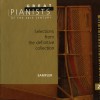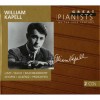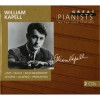| Voice/Instrument: |
Biography
William Kapell (September 20, 1922 – October 29, 1953) was an American pianist.
Kapell was born in New York City. His father was of Spanish-Russian Jewish ancestry and his mother of Polish descent.There he studied with Dorothea Anderson La Follette, then with Olga Samaroff in Philadelphia and at the Juilliard School.
Kapell won his first competition at the age of ten. The prize was a turkey dinner with the pianist José Iturbi. In 1941, he won the Philadelphia Orchestra's youth competition and the Naumburg Award. The following year, the Walter W. Naumburg Foundation sponsored the 19 year old pianist's New York début which brought him The Town Hall Award for the year's outstanding concert by a musician under 30. He was immediately signed to an exclusive recording contract with RCA.
Kapell had achieved fame while in his early twenties, most especially by his performances of Khachaturian's Piano Concerto in D flat, his world premiere recording of which was an enormous hit. Eventually, he became so associated with the concerto that he was nicknamed "Khachaturian Kapell". Besides his exciting pianism, Kapell's good looks and mop of unruly black hair helped make him a hit with audiences.
By the late 1940s, Kapell had toured the United States, Canada, Europe and Australia to immense acclaim and was widely considered the most brilliant and audacious of young American pianists. In 1947, he wed Rebecca Anna Lou Melson, with whom he had two children.
There was some tendency to typecast Kapell as a performer of flashy repertory. While his technique was exceptional, he was a versatile musician, and could also give memorably graceful performances of Mozart and Scarlatti. Kapell practiced up to eight hours a day, keeping track of his sessions with a notebook and clock. Kapell set aside time from his busy concert schedule to work with the artists he most admired, including Artur Schnabel, Pablo Casals, and Rudolf Serkin. He also approached Arthur Rubinstein and Vladimir Horowitz (who was a neighbor) for lessons, but they demurred. Horowitz later commented that there was nothing he could teach Kapell.
In the (southern) winter and spring of 1953, Kapell toured Australia, playing 37 concerts in 14 weeks, appearing in Sydney, Melbourne, Bendigo, Shepparton, Albury, Horsham and Geelong. In Geelong, Kapell played his last performance on October 22, shortly before setting off on his return flight to the United States. The plane hit Kings Mountain, south of San Francisco, on the morning of October 29, 1953. None of the crew or passengers survived.
Isaac Stern set up the William Kapell Memorial Fund to bring notable musicians to the USA for wider experience. The Australian violinist Ernest Llewellyn, a long time friend of Stern's, was the inaugural recipient in 1955.
The fascination with Kapell's playing continues in the decades since after his death. Pianists such as Eugene Istomin, Gary Graffman, Leon Fleisher and Van Cliburn, and classical-fusion jazz pianist Suezenne Fordham, among others, have acknowledged Kapell's influence. Fleischer stated that Kapell was "the greatest pianistic talent that this country [The United States] has ever produced". Kapell's widow – Anna Lou Dehavenon, a social anthropologist in New York – was a factor in helping to keep her husband's name alive.
Many of Kapell's recordings were originally issued as 78RPM records. Some were issued on LP, but by 1960, all of Kapell's commercial recordings were out of print. For decades, bootlegged copies of the commercial recordings and pirate recordings of "live" performances circulated among collectors.
In the 1980s, RCA released two compact discs of Kapell's recordings, including the Prokofiev and Khatchaturian piano concertos, and an all-Chopin disc.
A nine CD survey released by RCA in 1998 contains Kapell's renditions of Chopin's mazurkas and sonatas as well as concertos by Rachmaninoff, Prokofiev, and Khatchaturian. It also has many lesser-known items, some of them first releases, including Shostakovich preludes, Scarlatti sonatas, and the Copland Piano Sonata. The set sold remarkably well throughout the world and brought Kapell's work to a new audience.
VAI 1027 contains broadcast recordings of the Rachmaninoff Piano Concerto No. 3 and the Khatchaturian Piano Concerto. Arbiter 108 features part of the Beethoven Piano Concerto No. 3 and the Shostakovich Concerto No. 1, and it includes Mussorgsky's Pictures at an Exhibition, which also appears in the RCA set, as well as on VAI 1048, the last from an Australian recital of July 21, 1953.
In 2004, a number of recordings made during William Kapell's last Australian tour were returned to his family. These were released by Sony/BMG in 2008 as Kapell Rediscovered.







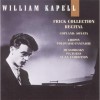
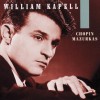
![Casals Festivals at Prades [CD6 of 13]](http://static.classicalm.com/repository/disk-cover/small/3624-img1404994003863213.jpg)
![Casals Festivals at Prades [CD7 of 13]](http://static.classicalm.com/repository/disk-cover/small/3625-img1404996799455193.jpg)
![The Heifetz Collection, Volume 8 [2 CD]](http://static.classicalm.com/repository/disk-cover/small/929-img1316982090166364.jpg)
